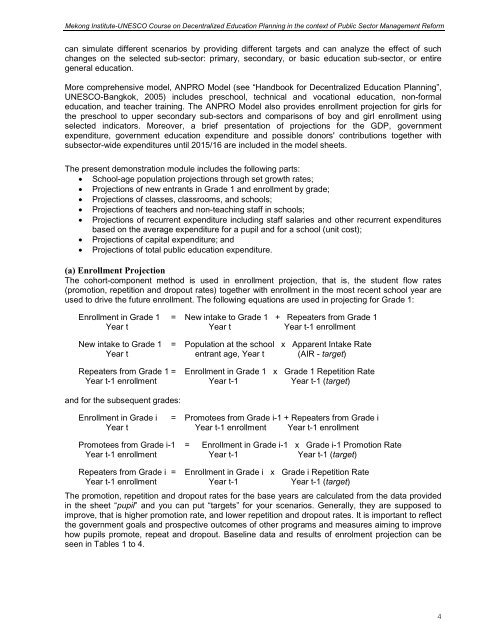Education Analysis and Projection Model - UNESCO Bangkok
Education Analysis and Projection Model - UNESCO Bangkok
Education Analysis and Projection Model - UNESCO Bangkok
You also want an ePaper? Increase the reach of your titles
YUMPU automatically turns print PDFs into web optimized ePapers that Google loves.
Mekong Institute-<strong>UNESCO</strong> Course on Decentralized <strong>Education</strong> Planning in the context of Public Sector Management Reformcan simulate different scenarios by providing different targets <strong>and</strong> can analyze the effect of suchchanges on the selected sub-sector: primary, secondary, or basic education sub-sector, or entiregeneral education.More comprehensive model, ANPRO <strong>Model</strong> (see “H<strong>and</strong>book for Decentralized <strong>Education</strong> Planning”,<strong>UNESCO</strong>-<strong>Bangkok</strong>, 2005) includes preschool, technical <strong>and</strong> vocational education, non-formaleducation, <strong>and</strong> teacher training. The ANPRO <strong>Model</strong> also provides enrollment projection for girls forthe preschool to upper secondary sub-sectors <strong>and</strong> comparisons of boy <strong>and</strong> girl enrollment usingselected indicators. Moreover, a brief presentation of projections for the GDP, governmentexpenditure, government education expenditure <strong>and</strong> possible donors' contributions together withsubsector-wide expenditures until 2015/16 are included in the model sheets.The present demonstration module includes the following parts:• School-age population projections through set growth rates;• <strong>Projection</strong>s of new entrants in Grade 1 <strong>and</strong> enrollment by grade;• <strong>Projection</strong>s of classes, classrooms, <strong>and</strong> schools;• <strong>Projection</strong>s of teachers <strong>and</strong> non-teaching staff in schools;• <strong>Projection</strong>s of recurrent expenditure including staff salaries <strong>and</strong> other recurrent expendituresbased on the average expenditure for a pupil <strong>and</strong> for a school (unit cost);• <strong>Projection</strong>s of capital expenditure; <strong>and</strong>• <strong>Projection</strong>s of total public education expenditure.(a) Enrollment <strong>Projection</strong>The cohort-component method is used in enrollment projection, that is, the student flow rates(promotion, repetition <strong>and</strong> dropout rates) together with enrollment in the most recent school year areused to drive the future enrollment. The following equations are used in projecting for Grade 1:Enrollment in Grade 1 = New intake to Grade 1 + Repeaters from Grade 1Year t Year t Year t-1 enrollmentNew intake to Grade 1 = Population at the school x Apparent Intake RateYear t entrant age, Year t (AIR - target)Repeaters from Grade 1 = Enrollment in Grade 1 x Grade 1 Repetition RateYear t-1 enrollment Year t-1 Year t-1 (target)<strong>and</strong> for the subsequent grades:Enrollment in Grade i = Promotees from Grade i-1 + Repeaters from Grade iYear t Year t-1 enrollment Year t-1 enrollmentPromotees from Grade i-1 = Enrollment in Grade i-1 x Grade i-1 Promotion RateYear t-1 enrollment Year t-1 Year t-1 (target)Repeaters from Grade i = Enrollment in Grade i x Grade i Repetition RateYear t-1 enrollment Year t-1 Year t-1 (target)The promotion, repetition <strong>and</strong> dropout rates for the base years are calculated from the data providedin the sheet “pupil” <strong>and</strong> you can put “targets” for your scenarios. Generally, they are supposed toimprove, that is higher promotion rate, <strong>and</strong> lower repetition <strong>and</strong> dropout rates. It is important to reflectthe government goals <strong>and</strong> prospective outcomes of other programs <strong>and</strong> measures aiming to improvehow pupils promote, repeat <strong>and</strong> dropout. Baseline data <strong>and</strong> results of enrolment projection can beseen in Tables 1 to 4.4
















